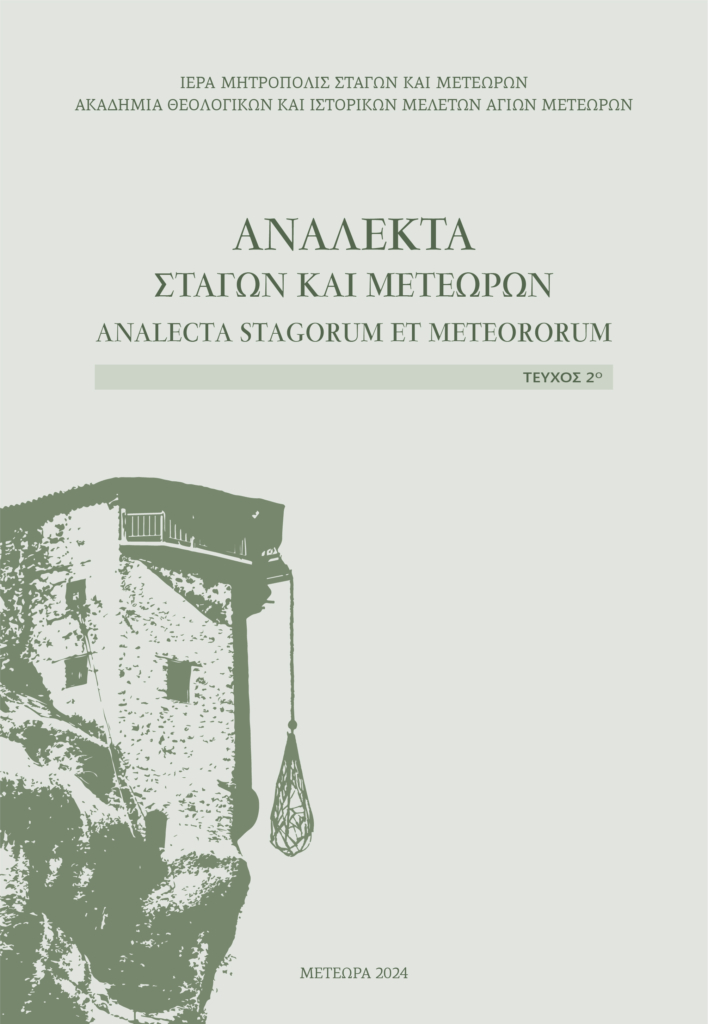Editorial
The second issue of Analecta Stagorum et Meteororum, published by the Diocesan Academy of Theological and Historical Studies of the Holy Meteora, continues to explore new avenues in the study of the monastic center of Meteora through interdisciplinarity.
The issue opens with Chrysovalantis Kyriacou’s article, which examines the notion of “height” in relation to Meteora. Kyriacou draws connections to the tradition of ancient stylitism and the concept of the “holy mountain” in ascetic practice, offering a new perspective on the sacred connotations conveyed by height in Eastern Orthodoxy.
Phokion Kotzageorgis follows with a critical assessment of the unpublished documents from the Ottoman archive of the Great Meteoron Monastery that date to the 15th century. Kotzageorgis demonstrates that this transitional century was characterized by the monastery’s economic expansion and effective adaptation to Ottoman rule rather than decline. The study also highlights a net of interactions between the monks and Ottoman actors, revealing the social dynamics of the period.
Styliani Lepida also delves into the Ottoman period, focusing on the confiscation of property from the Great Meteoron Monastery that took place in 1568/9 and its subsequent recovery. Her research includes the publication and English translation of key documents, making her work particularly valuable for researchers.
Demetrios Agoritsas’s article explores the metochia (dependencies) of Thessalian monasteries in Osdina, Thesprotia. This study offers new insights into an under-researched area of monastic history and examines the individuals involved in the “Petropoulos scandal.”
An interdisciplinary article by Georgios Boudalis, Anna Karatzani, Joy Boutrup, and Nikolaos Toutos examines the binding of the 14th-century parchment codex EBE 58, the so-called Gospel Book of Saint Joasaph. This rare late medieval binding, kept in the National Library of Greece, provides important information on Byzantine bookbinding techniques and cultural history.
In the section on art and culture, Lilyana Yordanova assesses the work of the famed painter Frangos Katellanos, focusing on the decorative motifs of his workshop and their Ottoman sources, as well as the rationale behind their inclusion in the iconographic programs of three churches.
Athina Zoupanti, Maria Xenariou, Mirka Palioura, and Konstantinos J. Stefanis explore 19th-century travel literature, particularly through a bibliographic list of twenty-six texts from the Efstathios J. Finopoulos Collection of the Benaki Museum. These texts offer valuable historical information on the state of Meteora monasteries during the 19th century.
The final research article by Spyridon Vlioras presents a study on the etymology of the toponym Kalambaka, engaging with local traditions and history to offer a new understanding of the town’s name.
The archaeological appendix by Krystallia Mantzana provides an overview of the monumental topography of Chasia, the “other Meteora,” covering the churches and monasteries in the region from the 11th to the 19th century.
Spiridion Azopardi’s report on the restoration of the late medieval clock at the Great Meteoron Monastery brings attention to one of the oldest devices that measure and display time in an Eastern Orthodox monastery.
The issue concludes with a review by Elias Giarenis of the festschrift Ἄμητος (Amitos) in tribute to Charalambos Stergioulis, a founding member of the Academy, highlighting his contributions to the field.
This second issue continues to enrich the study of Meteora, offering valuable insights across a variety of disciplines, from history and material culture to art and literature.


